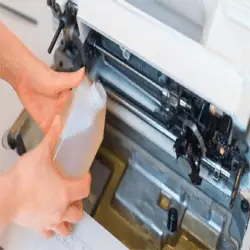
Oiling a sewing machine is so easy. If you wanna know how to oil a sewing machine then read our step-by-step guide.
If you are looking for a way to keep your sewing machine in top shape, then this blog post is for you!
We will discuss how to oil a sewing machine so that it operates smoothly and doesn’t break down. Keep reading to find out more about this simple maintenance task.
- Why Oil A Sewing Machine?
- How Often Do I Need To Oil A Sewing Machine?
- What Kind of Oil Should I Use?
- How To Oil A Sewing Machine – Complete Guide?
- What To Do After Oiling?
- Overall Verdict
Why Oil A Sewing Machine?
The sewing machine’s motor needs oil to run smoothly and without strain. The oil lubricates the gears, bearings, and other parts of the sewing machine so that they work easily together.
This will help you avoid any malfunctions or breakages which can be expensive for your business!
How Often Do I Need To Oil A Sewing Machine?
The frequency of oiling depends on the type of sewing machine and how often it is used. Some sewers may need to oil their machines weekly, others monthly or yearly.
It’s important to remember that you should never use any other kind of lubricant besides sewing machine oil!
What Kind of Oil Should I Use?
You have some options when considering what kind of oil you need for your machine.
The two major types – synthetic and mineral – both have their benefits. Neither, however, will damage your machine, so long as they are applied properly.
Synthetic Oil:
synthetic oil is lightweight and does not leave an oily residue on the fabric. It also has a very low viscosity so it can penetrate deep into the machine’s moving parts, making them work better for you over time.
The downside to synthetic oil is that some people find they need to apply it more often than with mineral oils or other types of lubricants.
One way to avoid this problem may be by using our PCS Lubricant Spray as opposed to applying liquid oil directly onto your sewing machine – just spritz down any part that moves at least once every six months (or if you notice any problems).
Another option would be taking advantage of one of our many kits like the Singer Sewing Machine Maintenance Kit so you can oil your machine on a regular basis.
Mineral oil:
This kind of oil can be used with any sewing machine, whether it’s a mechanical or electronic model. If a machine is compatible, then mineral oils are the best type of lubricant to use.
It has properties that make it not only long-lasting but also able to withstand high temperatures and still remain effective – so even if you’re working with fabrics like leather or vinyl, this will be great for your sewing needs.
One thing you should know about mineral oil is that it can leak, so if you have a place for your machine where it won’t be in contact with fabric or carpet then using this type might not be such as a bad idea.
Mineral oils are costlier than synthetics but they also last longer and work well at high temperatures.
One downside to using mineral oils on machines without built-in drip pans is that these liquids will run out onto whatever surface the machine sits on when you’re not using it – which means potential messes down the road!
You’ll want to apply liquid lubricant (mineral) sparingly: just put two drops directly.
A Few Extra Tips:
- Oil the needle bar once per year and then every few months, even if it doesn’t seem to be in need of any lubrication. This will help prevent problems like skipped stitches or thread breaking.
- Apply new sewing machine oil when changing your sewing gearbox (your transmission). Doing this will ensure that all parts are properly lubed for optimal performance. Oil changes should also happen whenever fabric starts shredding instead of feeding smoothly through the needle area, as well – and make sure you have ample light to see what’s going on while performing maintenance tasks!
How To Oil A Sewing Machine?
Once you’ve gathered the appropriate materials, like a few tools and oil for your car engine, it’s time to get started.
Clean The Sewing Machine
Clean the sewing machine with soap and water, then dry it thoroughly before oiling. You’ll want to remove any dust or dirt that may have accumulated on its surface after being switched off for a while, as these can contribute to premature wear of the needle assembly.
The first few steps are also necessary if you’re performing an oil change following a gearbox transmission replacement (see below).
Oiling A Sewing Machine
Prepare Supplies Needed For Oiling The Sewing Machine:
Before you start taking any steps towards oiling the sewing machine, make sure all necessary materials have been gathered beforehand.
This includes rags, cotton balls (or Q-tips), turpentine or mineral spirits paint thinner (which can be used as substitutes for turpentine), and an old toothbrush.
Take The Sewing Machine Apart:
To complete this task, the sewing machine needs to be taken apart so that access to all of its moving parts is possible.
This includes taking off the needle plate and belt cover which are usually screwed on or clipped in place while also removing any attachments such as bobbins, spools of thread, or even a foot pedal used for controlling sewing speed and pressure among other things.
Once these items have been removed, wipe down everything with turpentine before proceeding to step three.
Clean Parts With Turpentine Or Paint Thinner:
Using cotton balls dipped in either turpentine or paint thinner (whichever you might happen to have) clean up every inch of the inside surface of the machine.
This includes any parts such as gears, screws, and on-off switches that might be too difficult to clean otherwise with a small brush or cotton swab.
Apply Oil To The Machine Assembly:
In order for your sewing machine to continue working in top condition, you need to apply the oil directly where it is needed most which is typically anywhere metal touches other metal but also in places like between moving belts.
What To Do After Oiling?
It’s a good idea to sew on an extra piece of fabric as soon as you oil your sewing machine.
Sometimes too much oil can accidentally find its way into the machine and get absorbed by sewing, which is why it’s important that no matter what kind of material scraps are available, they should be used in order to protect the thread from excess oils.
Depending on the model, however–depending on if there is anything special about how this particular type or brand does things–it may have some peculiarities due to running off before giving out warning signs such as flashing lights so always make sure you read up beforehand just in case!
Overall Verdict
We hope this article has brought you some clarity. All of the information provided should help to answer any questions about how to oil a sewing machine and keep your fabric moving quickly through the needle with minimal resistance.
If you have any further queries or need more advice, please feel free to get in touch via our contact page.
In closing, we want you all to know that it is important not only for your sewing machine’s longevity but also for its performance to be properly lubricated on a regular basis. So don’t forget!

Robert Patricia
Robert Patricia is a data analytic and content creator. He has worked extensively with large data sets to glean insights for both public and private sector clients. He has used this knowledge to create compelling content for brands across the internet. Albert also enjoys creating content for websites and social media. He is an expert at creating catchy headlines and understands how to capture the attention of readers.
